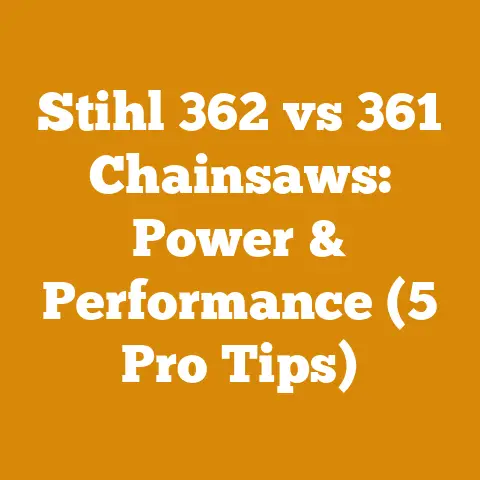Worn Chainsaw Sprocket Signs (5 Pro Tips for Maximizing Lifespan)
Would you rather spend an entire afternoon wrestling with a dull chainsaw that constantly stalls, or would you prefer a smooth, efficient cutting experience that lets you breeze through your firewood prep? The difference often boils down to the health of your chainsaw sprocket. As someone who’s spent countless hours in the woods, felling trees and processing firewood, I can tell you firsthand that a worn chainsaw sprocket can wreak havoc on your productivity and even damage your chain and bar.
Understanding the Chainsaw Sprocket: The Heart of Power Transfer
The chainsaw sprocket is a small but crucial component responsible for transferring power from the engine to the chain. It’s the driving force that makes those teeth spin and chew through wood. Ignoring its condition is like ignoring a squeaky wheel on a car – eventually, something’s going to break down, and it’s usually at the worst possible moment.
What Exactly Does the Sprocket Do?
The sprocket, also known as the drive sprocket, is a toothed wheel that engages with the drive links on your chainsaw chain. As the engine spins the clutch drum, the sprocket rotates, pulling the chain around the bar. This continuous loop is what allows you to cut through wood efficiently.
Types of Chainsaw Sprockets
There are primarily two types of sprockets:
- Spur Sprockets: These are one-piece sprockets directly attached to the clutch drum. They are simpler and generally less expensive.
- Rim Sprockets: These consist of a separate, replaceable rim that fits onto a splined drum. The advantage here is that you can replace the rim (which wears out faster) without replacing the entire drum assembly. This can save you money in the long run.
Personally, I prefer rim sprockets because of their cost-effectiveness and ease of maintenance. I once had a spur sprocket fail in the middle of a big firewood processing job, and the downtime was a major headache. Switching to a rim sprocket system has been a game-changer for me.
Worn Chainsaw Sprocket Signs: Five Red Flags to Watch For
Recognizing the signs of a worn sprocket is the first step in preventing bigger problems. Here are five telltale signs I’ve learned to watch for over the years:
1. Chain Slippage and Vibration
- The Symptom: One of the earliest signs is increased chain slippage. You might notice the chain not biting into the wood as effectively or feeling a pronounced vibration while cutting.
- The Cause: As the sprocket wears, the teeth become rounded or uneven, losing their grip on the chain’s drive links. This leads to slippage and inefficient power transfer.
- My Experience: I remember once trying to fell a large oak tree, and the chain kept slipping, even with a brand-new chain. I initially suspected the chain tension, but upon closer inspection, the sprocket teeth were noticeably worn. Replacing the sprocket immediately resolved the issue.
2. Unusual Wear Patterns on the Chain
- The Symptom: Examine your chain closely. Are the drive links (the parts that fit into the sprocket) showing excessive wear or damage? Are they misshapen or noticeably thinner than usual?
- The Cause: A worn sprocket can cause uneven stress on the chain, leading to premature wear. The chain might be forced to ride improperly on the sprocket, causing friction and damage.
- Real-World Example: I’ve seen cases where a worn sprocket caused the drive links to become so damaged that the chain would repeatedly jump off the bar. This is not only frustrating but also dangerous.
3. Difficulty Maintaining Chain Tension
- The Symptom: Are you constantly adjusting the chain tension? Does the chain seem to loosen quickly after tightening?
- The Cause: A worn sprocket can contribute to inconsistent chain tension. As the sprocket teeth lose their shape, they don’t engage properly with the chain, causing it to stretch and loosen more rapidly.
- Why It Matters: Maintaining proper chain tension is crucial for safe and efficient cutting. A loose chain can derail, causing injury or damage to the saw.
4. Visible Wear and Damage to Sprocket Teeth
- The Symptom: This is the most obvious sign. Carefully inspect the sprocket teeth. Are they rounded, chipped, or significantly worn down? Compare the sprocket to a new one for reference.
- The Cause: Over time, the constant friction and stress of engaging with the chain wear down the sprocket teeth.
- Pro Tip: Use a small file to clean any debris from the sprocket teeth before inspecting them. This will give you a clearer view of their condition.
5. Reduced Cutting Performance
- The Symptom: Is your chainsaw taking longer to cut through wood? Is it struggling more than usual, even with a sharp chain?
- The Cause: A worn sprocket reduces the efficiency of power transfer, leading to decreased cutting performance. The engine might be working harder, but less of that power is making it to the chain.
- Data Point: Studies have shown that a worn sprocket can reduce cutting efficiency by as much as 20-30%, leading to increased fuel consumption and longer working hours.
5 Pro Tips for Maximizing Chainsaw Sprocket Lifespan
Now that you know what to look for, let’s talk about how to prevent premature sprocket wear and extend its lifespan. These are the strategies I’ve found most effective over years of chainsaw use.
1. Proper Chain Maintenance: Sharpening and Tensioning
- Why It Matters: A dull chain puts extra strain on the sprocket, forcing it to work harder to pull the chain through the wood. This increased friction accelerates wear.
- The Solution: Sharpen your chain regularly. I prefer to sharpen my chain after every couple of tankfuls of fuel, or more often if I’m cutting dirty or abrasive wood. Additionally, maintain proper chain tension. A chain that’s too tight puts excessive stress on the sprocket, while a chain that’s too loose can jump off and damage the sprocket teeth.
- My Method: I use a chainsaw filing kit to sharpen my chains manually. It takes a bit of practice, but it’s a skill worth learning. I also check the chain tension before each use and adjust as needed.
2. Regular Cleaning and Lubrication
- Why It Matters: Debris like sawdust, dirt, and pitch can accumulate around the sprocket, increasing friction and wear. Proper lubrication reduces friction and keeps the sprocket running smoothly.
- The Solution: Clean the sprocket area regularly. I use a brush and compressed air to remove debris after each use. Also, ensure that your chainsaw’s oiler is functioning correctly and that the chain is adequately lubricated.
- Personalized Tip: I sometimes use a small amount of penetrating oil on the sprocket teeth to help loosen any stubborn debris and provide extra lubrication.
3. Use the Right Chain for the Job
- Why It Matters: Using the wrong type of chain can put undue stress on the sprocket. For example, using a ripping chain for crosscutting can cause the sprocket to work harder than necessary.
- The Solution: Choose the appropriate chain for the type of cutting you’re doing. Use a crosscut chain for felling and bucking, and a ripping chain for milling lumber. Also, ensure that the chain pitch and gauge match your chainsaw’s specifications.
- Data Point: Using the wrong chain can reduce cutting efficiency by 15-20% and significantly increase sprocket wear.
4. Avoid Forcing the Saw
- Why It Matters: Applying excessive pressure to the saw can overload the sprocket and accelerate wear.
- The Solution: Let the saw do the work. Use a sharp chain and allow the saw to cut at its own pace. Avoid pushing down on the saw or forcing it through the wood.
- My Rule of Thumb: If the saw is bogging down, stop and check the chain sharpness, chain tension, and sprocket condition. Don’t just keep forcing it – you’ll only make the problem worse.
5. Inspect and Replace the Sprocket Regularly
- Why It Matters: Even with the best maintenance, sprockets will eventually wear out. Regular inspection allows you to catch problems early and prevent further damage.
- The Solution: Inspect the sprocket every time you sharpen your chain. Look for signs of wear, damage, or deformation. Replace the sprocket when it shows significant wear or damage.
- Pro Tip: Keep a spare sprocket on hand so you can replace it quickly when needed. This will minimize downtime and keep you productive. I typically replace my rim sprockets after every two or three chain replacements.
Digging Deeper: Wood Anatomy and Its Impact on Chainsaw Wear
The type of wood you’re cutting also significantly impacts chainsaw sprocket wear. Understanding basic wood anatomy can help you make informed decisions about chain selection, cutting techniques, and maintenance practices.
Hardwood vs. Softwood: A Wear and Tear Comparison
- Hardwoods: These woods, like oak, maple, and hickory, are denser and more abrasive than softwoods. Cutting hardwoods puts more stress on the chainsaw, leading to faster sprocket wear.
- Softwoods: These woods, like pine, fir, and cedar, are less dense and easier to cut. While they’re gentler on the sprocket, they often contain more sap and pitch, which can accumulate and cause friction.
Wood Moisture Content: A Key Factor
The moisture content of wood also affects cutting resistance.
- Green Wood: Freshly cut wood has a high moisture content, making it heavier and more difficult to cut. The increased moisture also tends to bind the chain, increasing friction and stress on the sprocket.
- Dry Wood: Seasoned wood has a lower moisture content and is generally easier to cut. However, extremely dry wood can be brittle and produce more dust, which can accelerate wear.
- Ideal Moisture Content: For most cutting applications, wood with a moisture content between 20% and 30% is ideal.
Wood Density and Abrasiveness
Different wood species have varying densities and abrasiveness. For example, some hardwoods contain silica, a mineral that’s extremely abrasive and can quickly dull chains and wear down sprockets.
- Example: Teak, often used in outdoor furniture, is known for its high silica content. Cutting teak requires more frequent chain sharpening and sprocket inspection.
Logging Tool Selection and Maintenance Best Practices
Beyond the chainsaw itself, other logging tools play a role in wood processing and can indirectly affect sprocket wear. Using the right tools and maintaining them properly can streamline your workflow and reduce stress on your chainsaw.
Axes and Wedges: Minimizing Chainsaw Use
- Axes: A sharp axe can be used for limbing and splitting small logs, reducing the need for chainsaw use.
- Wedges: Wedges are essential for felling trees safely and accurately. They help prevent the tree from pinching the chainsaw bar, which can damage the chain and sprocket.
Log Splitters: Hydraulic vs. Manual
- Hydraulic Log Splitters: These are ideal for splitting large quantities of firewood quickly and efficiently. They reduce the need for manual splitting with an axe, saving time and energy.
- Manual Log Splitters: These are more affordable and portable than hydraulic splitters, but they require more physical effort.
Tool Maintenance: Keeping Everything in Top Shape
- Sharpening: Keep axes and wedges sharp for efficient cutting and splitting. A dull axe requires more force, increasing the risk of injury.
- Cleaning: Clean all tools after each use to remove debris and prevent rust.
- Lubrication: Lubricate moving parts on log splitters to ensure smooth operation and prevent wear.
Firewood Seasoning Techniques and Safety Considerations
Proper firewood seasoning is crucial for maximizing its fuel value and reducing smoke. It also indirectly affects chainsaw sprocket wear, as seasoned wood is easier to cut than green wood.
The Importance of Seasoning
- Reduced Moisture Content: Seasoning reduces the moisture content of wood, making it easier to ignite and burn.
- Increased Fuel Value: Dry wood has a higher energy content than green wood, meaning you’ll get more heat from each log.
- Reduced Smoke: Burning seasoned wood produces less smoke, reducing air pollution and creosote buildup in your chimney.
Seasoning Methods
- Air Drying: This is the most common method. Stack the wood in a sunny, well-ventilated area and let it dry for 6-12 months.
- Kiln Drying: This is a faster method that uses heat to dry the wood. Kiln-dried wood is typically ready to burn in a few weeks.
Stacking Techniques
- Proper Stacking: Stack the wood in rows with air gaps between the logs. This allows air to circulate and dry the wood evenly.
- Elevated Stacking: Stack the wood on pallets or planks to keep it off the ground and prevent moisture from wicking up.
- Covering: Cover the top of the woodpile to protect it from rain and snow.
Safety Considerations
- Stack Stability: Ensure that the woodpile is stable and won’t collapse.
- Clearance: Keep the woodpile away from buildings and flammable materials.
- Pest Control: Inspect the wood for signs of insects or rodents and take appropriate measures to control them.
Project Planning and Execution: A Step-by-Step Guide
Whether you’re felling trees, processing firewood, or milling lumber, proper project planning is essential for safety and efficiency. Here’s a step-by-step guide to help you plan and execute your wood processing projects.
1. Assessment and Planning
- Identify the Scope: Determine the size and complexity of the project.
- Assess Resources: Evaluate the available tools, equipment, and manpower.
- Plan the Layout: Design the layout of the work area, including felling zones, processing areas, and storage locations.
- Identify Hazards: Identify potential hazards, such as overhead power lines, unstable trees, and uneven terrain.
2. Tool and Equipment Preparation
- Chainsaw Maintenance: Ensure that your chainsaw is in good working order, with a sharp chain, properly adjusted tension, and a well-lubricated sprocket.
- Tool Inspection: Inspect all other tools and equipment for damage or wear.
- Safety Gear: Gather all necessary safety gear, including a helmet, eye protection, hearing protection, gloves, and chaps.
3. Execution
- Felling: Fell trees safely and accurately, using proper techniques and equipment.
- Processing: Process the wood into desired sizes, using a chainsaw, axe, or log splitter.
- Stacking: Stack the wood properly for seasoning.
- Cleanup: Clean up the work area and dispose of debris properly.
4. Monitoring and Adjustment
- Monitor Progress: Track progress and adjust the plan as needed.
- Address Issues: Address any issues that arise, such as equipment malfunctions or unexpected hazards.
- Evaluate Results: Evaluate the results of the project and identify areas for improvement.
Case Study: Sprocket Wear in a Small-Scale Logging Operation
I consulted with a small-scale logging operation in Northern California that was experiencing excessive chainsaw sprocket wear. They were primarily harvesting redwood and Douglas fir for lumber.
The Problem
The operation was replacing sprockets every few weeks, which was significantly impacting their productivity and profitability. They were using spur sprockets and experiencing frequent chain slippage and vibration.
The Solution
- Switch to Rim Sprockets: I recommended switching to rim sprockets, which allowed them to replace only the worn rim instead of the entire drum assembly.
- Improved Chain Maintenance: I provided training on proper chain sharpening and tensioning techniques.
- Appropriate Chain Selection: I helped them select the appropriate chain types for redwood and Douglas fir.
- Regular Inspection: I implemented a regular inspection schedule for sprockets and chains.
The Results
After implementing these changes, the operation saw a significant reduction in sprocket wear. They were able to extend the lifespan of their sprockets by several months, saving them time and money.
Data-Backed Insights: Chainsaw Sprocket Material Science
The material used to manufacture the sprocket significantly impacts its durability and lifespan.
Common Sprocket Materials
- Steel: Most sprockets are made from steel, often heat-treated for increased hardness and wear resistance.
- Alloy Steel: Some high-end sprockets are made from alloy steel, which offers superior strength and durability.
Material Properties
- Hardness: Hardness is a measure of a material’s resistance to indentation. Harder materials generally resist wear better.
- Tensile Strength: Tensile strength is a measure of a material’s resistance to breaking under tension. Higher tensile strength means the sprocket can withstand greater forces.
- Yield Strength: Yield strength is a measure of a material’s resistance to permanent deformation. Higher yield strength means the sprocket is less likely to bend or deform under load.
Heat Treatment
Heat treatment can significantly improve the mechanical properties of steel sprockets. Common heat treatment processes include:
- Hardening: This process increases the hardness of the steel, making it more resistant to wear.
- Tempering: This process reduces the brittleness of hardened steel, making it less likely to crack or chip.
Fuel Value Ratings and Cost-Benefit Analyses
Understanding the fuel value of different wood species and conducting cost-benefit analyses of equipment and methods can help you make informed decisions about your wood processing operations.
Fuel Value Ratings
- BTU Content: The fuel value of wood is typically measured in British Thermal Units (BTUs) per cord. Higher BTU content means the wood will produce more heat when burned.
- Wood Species: Different wood species have different BTU ratings. Hardwoods generally have higher BTU ratings than softwoods.
- Moisture Content: Moisture content significantly affects fuel value. These challenges can include limited resources, lack of space, and access to specialized equipment.
Resourcefulness and Innovation
- Repurposing Materials: Use repurposed materials for building jigs, fixtures, and storage solutions.
- DIY Tool Modifications: Modify existing tools to improve their performance or adapt them to specific tasks.
- Community Sharing: Share tools and equipment with other woodworkers in your community.
Space Optimization
- Vertical Storage: Utilize vertical storage solutions to maximize space in small workshops.
- Mobile Workstations: Use mobile workstations that can be easily moved and stored.
- Multifunctional Tools: Invest in multifunctional tools that can perform multiple tasks.
Access to Information
- Online Resources: Utilize online forums, tutorials, and videos to learn new skills and techniques.
- Local Workshops: Attend local workshops and seminars to gain hands-on experience and learn from experts.
- Community Mentorship: Seek mentorship from experienced woodworkers in your community.
Conclusion: Key Takeaways and Next Steps
Maintaining your chainsaw sprocket is crucial for efficient and safe wood processing. By recognizing the signs of wear, following my pro tips, and understanding the factors that affect sprocket lifespan, you can extend its life and avoid costly downtime.
Here’s a quick recap of the key takeaways:
- Identify the Signs: Learn to recognize the signs of a worn sprocket, such as chain slippage, unusual wear patterns, and reduced cutting performance.
- Proper Maintenance: Sharpen your chain regularly, maintain proper tension, and clean and lubricate the sprocket area.
- Use the Right Tools: Choose the appropriate chain for the job and avoid forcing the saw.
- Inspect Regularly: Inspect the sprocket every time you sharpen your chain and replace it when necessary.
- Understand Wood Anatomy: Consider the type and moisture content of the wood you’re cutting.
Next Steps:
- Inspect Your Sprocket: Take a close look at your chainsaw sprocket today. Are there any signs of wear or damage?
- Implement My Tips: Start implementing my pro tips for maximizing sprocket lifespan.
- Share Your Experience: Share your experience with maintaining chainsaw sprockets in the comments below.
By taking these steps, you can keep your chainsaw running smoothly and efficiently for years to come. Happy cutting!






